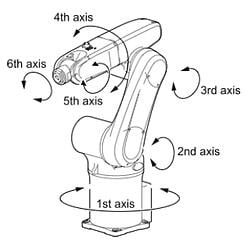How Can Industrial Robot Accuracy Be Improved?
Posted on Nov 06, 2014 in Robots
3 min read time
When you buy a robot, you are kind of stick with its accuracy. Unfortunately there is no magic solutions for this problem, however, there is way to reduce the inacuracy of your system. Maybe we can help you think about what are the likely scenarios that can generate inaccuracies and potentially removing them.
 Industrial robots are increasingly used in industries catering mainly to advanced manufacturing (the link is really worth it) and precise handling tasks. The classic programming method was the so-called teaching approach (also called the on-line programming method). However, because of its time consuming disadvantage, this method (i.e. on-line programming) is today gradually being replaced by the so-called off-line programming method. To take full advantage of this method, the robots used should be characterized by the highest accuracy possible. In fact, since the robot has to go to a given position without any teaching, it should be extremely precise. Although, some industrial robots aren't capable of offering a sufficiently high accuracy rate to satisfy the high levels of precision required in some applications such as: precision machining, laser cutting and electronic component handling. For these you will most likely need specialized robots.
Industrial robots are increasingly used in industries catering mainly to advanced manufacturing (the link is really worth it) and precise handling tasks. The classic programming method was the so-called teaching approach (also called the on-line programming method). However, because of its time consuming disadvantage, this method (i.e. on-line programming) is today gradually being replaced by the so-called off-line programming method. To take full advantage of this method, the robots used should be characterized by the highest accuracy possible. In fact, since the robot has to go to a given position without any teaching, it should be extremely precise. Although, some industrial robots aren't capable of offering a sufficiently high accuracy rate to satisfy the high levels of precision required in some applications such as: precision machining, laser cutting and electronic component handling. For these you will most likely need specialized robots.
As stated in a past article, a robot's inaccuracy is attributed to three main factors:
-
Joint errors: Represented by inaccurate measurements that can occur at the joint(s).
-
Kinematic errors: Related to the kinematic parameters of the robot.
-
Non-kinematic errors: Other errors related to the mechanical aspect of the robot’s parts, including the links and the gearboxes.
 The obvious way to have greater accuracy in robots, is to initially associate high precision (i.e. small mechanical tolerances) with the machining and the assembling operations of their parts, which by the way increases dramatically the robots’ cost. Therefore, the adopted approach by robot manufacturers consists of manufacturing robots without using very restricted tolerances, but acceptable tolerances, which in a way allows for acceptable accuracy. The reverse of this is therefore also true. That the creation and addition of several inaccuracies combined together create the overall result of inaccuracy. This also means that each robot is not exactly the same, by using smaller tolerances, the robot manufacturers make sure to restrict the differences between all their robots.
The obvious way to have greater accuracy in robots, is to initially associate high precision (i.e. small mechanical tolerances) with the machining and the assembling operations of their parts, which by the way increases dramatically the robots’ cost. Therefore, the adopted approach by robot manufacturers consists of manufacturing robots without using very restricted tolerances, but acceptable tolerances, which in a way allows for acceptable accuracy. The reverse of this is therefore also true. That the creation and addition of several inaccuracies combined together create the overall result of inaccuracy. This also means that each robot is not exactly the same, by using smaller tolerances, the robot manufacturers make sure to restrict the differences between all their robots.
However, the robot accuracy can be improved - if necessary - by the customer through a specific operation called: robot calibration. This means that the manufactured robot must still offer a good repeatability, since this characteristic can not be improved through calibration. Robot calibration only allows for the improvement of the robots’ accuracy and this is divided into three categories, as determined by which group the errors are related to:
-
Joint calibration: Also called first level calibration, allows for the identification and compensation of the joint errors of the robot.
-
Kinematic calibration: Also called second level calibration, is dedicated to identifying and compensating for the errors of the robot’s kinematic parameters.
-
Non-kinematic calibration: Also called third level calibration, consist of modelizing the stiffness of the robot (including the temperature effects) and compensating for this back-lash.
Usually, adjustments in the joint and kinematic calibrations make the highest contribution to improving robot accuracy. However, the third level of calibration is vital in cases requiring a high payload or if the robot is used in an environment with grossly variable temperatures.







Leave a comment